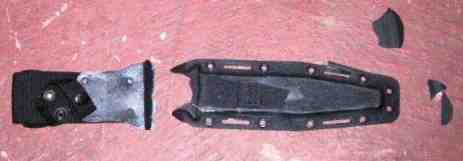
This work was initiated mainly as a responce to questions asked about kydex and cold temperatures. Personal use with the sheath of a Machax and Steel Eagle had showed kydex to be brittle as a sheathing material for knives. This idea had been discussed before and while at times some kydex makers would contend the issue of brittleness none would actually guarantee contradictory results with their sheaths and in fact would go further and note than any such work would void the warranty on their sheaths. Other makers were open about kydex having problems with impact in cold.
A basement freezer was used to cool the sheaths as it is currently summer here. The SOG provided a low end baseline mainly due to the way it is constructed but in any case it is reasonable to expect custom kydex work to be better in durability from a quality control viewpoint. Andrew's sheath should give a decent benchmark for custom work. The Bowie sheath was used to see if there was a significant different with the cordura covering.
The sheaths were hit with 25 ft.lbs of energy via a lead weight. Twenty five lbs is simply the energy provided by a five lbs weight dropped from five feet, in this case a 25 lbs lead weight was dropped from one foot. There is nothing magical about this amount of energy, it was chosen mainly because based on past experience it was reasoned it would be enough to break all the sheaths (it was significantly higher than the energies used in the past), and mainly it is a nice round number.
The sheaths were padded underneath with 1/2" of ridged cardboard simply to prevent the paint on the concrete floor from chipping, this obviously undercuts the energy of impact by absorbing it somewhat so the actual impact is less than 25 ft.lbs. This work wasn't to simply examine the break point, except in a gross sense (as it being less than 25 ft.lbs) the energy would need to be much smaller for that. This was mainly to look at the difference in the nature of the sheaths due to construction. The SOG sheath was first, it shattered into bits on the first impact :

The raised front and flat back shunts the energy directly into the sharp curvature and violently cracks it to pieces. The sheath was non functional after one impact. Andrew Lynch's sheath fared much better, the first impact was on the bottom half, the sheath flexed under the impact of the weight and then returned to true. It was only minorly damaged from the hit :

The second hit was above the half way point, resulting in functional damage done to the sheath :

The first impact on the Becker sheath was in the bottom half, on the pouch. The webbing just absorbed the impact (the sheath was cut open to examine the Kydex) without harm. However an impact on the top of the sheath again functionally damaged the sheath :

As an aside, it might be expected that since the pouch is split on the back and can thus open up and thus dissipate energy it would be more durable however it obviously can't do this fast enough to prevent it from cracking. For comparison, a cheap leather sheath (Marbles) was subjected to 100+ ft.lbs with no problems besides minor scuffing. On an interesting side note such high impacts (100+ ft.lbs) might be enough to break the knife in the sheath.
The above shows that there is a large difference in durability just based on how a sheath is made, some types are much more prone to breakage than others and in any case the impact toughness of Kydex is fairly low. In addition even a small bit of padding can greatly raise the durability, so even a simple cord wrap would be of considerable benefit.
To solve issues with Kydex and cold and durability in general, Andrew Lynch (email) and Carl Theile have worked with laminate Kydex/Kevlar sheaths which are much more durable [ref : 1, 2, 3]. Pictures :

Carl has also done Kydex/Leather laminates which have all the retention abilities of Kydex and have greater shock absorption due to the leather :

In addition he has also ran multiple layers of laminated Kydex :

Carl can be reached by email at cj_7@mindspring.com or by phone at (925) 373-6651 (voice) or through regular mail at Carl Theile 2774 Seventh St. Livermore, CA 94550 . For other hard use sheaths, there are other options such as the following from Chas Clements.
For really hard-use sheathes, I do a laminated construction. I take glove pigskin and laminate it to linen webbing- sometimes a dozen layers glued with contact cement and face sewn.
Aside from the sheath breaking, data can be seen on Kydex direct from the manufacturer which indicates that Kydex loses impact toughness by more than a factor of ten from room temperature to sub-zero temperatures) as the temperature drops.
Comments can be sent by email to : cliffstamp[REMOVE]@cutleryscience.com and seen in the following thread :
| Last updated : | Tue Jun 8 01:28:27 NDT 2004 |
| Originally written; | Fri Jun 4 13:50:13 NDT 2004 |